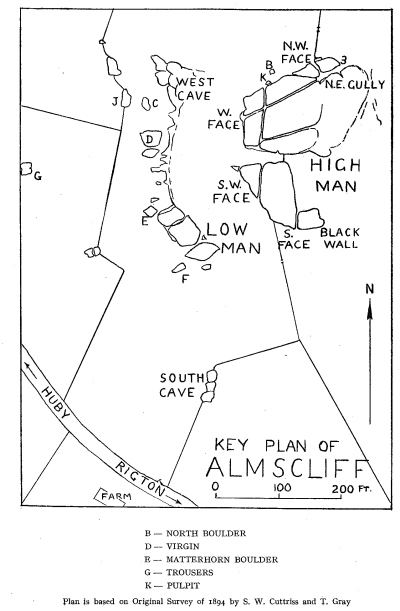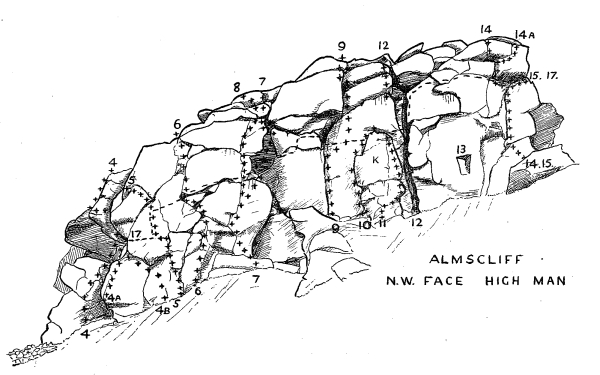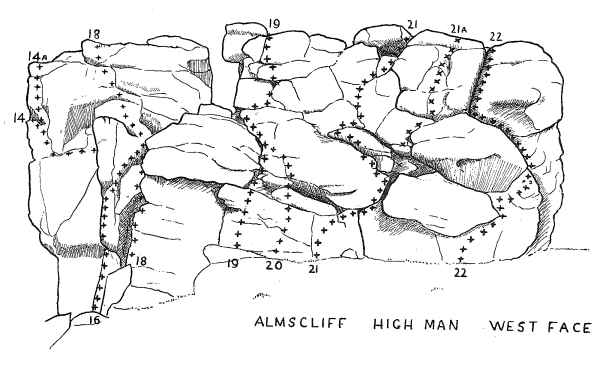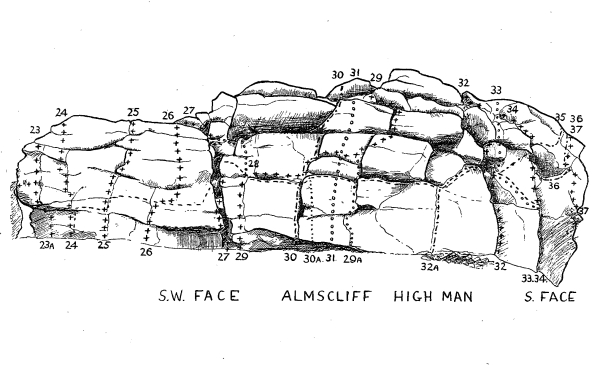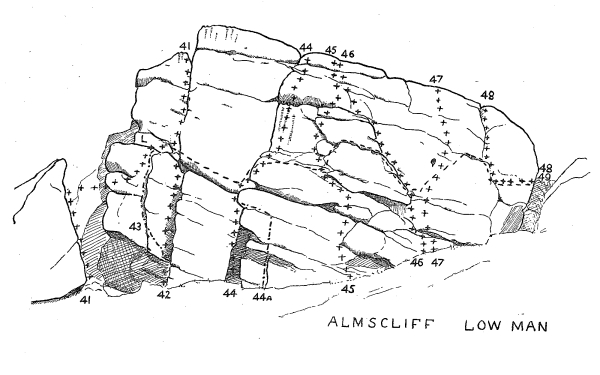ALMSCLIFF – A KEY TO CLIMBS
By H. L. Stembridge.
History. Mr. T. Gray, the first Editor of the Y.R.C. Journal, has given the history of the early days of sport on Almscliff.
The first few climbers were chemistry students at the Yorkshire College, of whom Herbert Ingle and Dent went first as far as is known, and about 1893 climbed the Long Chimney. Gray soon after joined Ingle, and together they did many of the now classic climbs, including the Cup Climb, Stomach Traverse, V Chimney and Long Traverse, and Square Chimney. Edward Calvert joined in later and the first ascent of the Bird’s Nest was made by Ingle after Calvert had attempted it and been compelled to jump down.
Several good climbers followed, notably Walter Parsons and Fred Botterill. It fell to Frankland in the 1920’s to develop the Face climbs, among them Central Face, Green Crack, and Traditional.
During recent years severe routes have been evolved by Dolphin, including Great Western, Demon Wall, and most difficult of all North-west Girdle Traverse.
Description. Almscliff is a Gritstone outcrop consisting of High Man, Low Man, and a large number of outlying boulders, the whole providing an excellent practice ground for the Rock Climber. The rock is clean and sound, it dries quickly and its rough texture enables much use to be made of friction and press holds. Many of the faces would be uncompromisingly clean had not a kindly providence slipped in a few delightful cupholds although some of them are barely sufficient to hold one finger. Most of the climbs are well nail-scratched.
The High Man, which is divided into two main blocks, presents steep faces to the North, West and South, but overhangs are often encountered. The main face of the Low Man faces South West, but there is a lesser face looking towards the North West which lies beneath a great overhang. The Boulders round the crag on the N.W. provide innumerable short problems of which it is only necessary to list the main ones.
Position. 4¾ miles S.W. of Harrogate ; 4¾ miles E,N,E. of Otley; 10 miles N. of Leeds. O.S. Map reference (1/25000-44/24) 268490. Height above sea level 700 ft. approx.
Access. From Bradford/Harrogate or Otley/Harrogate bus dismount at Wescoe Hill, Holly Park or Rigton Lane, any of which points is 25 minutes’ walk from Almscliff. By train. Weeton Station between Leeds and Harrogate is 25 minutes’ walk away.
Campers can obtain water from a small spring 120 yards N.E. of N.E. gully. A pure stream runs through Crag Wood on private land.
Note. The object of this key is to enable the reader to identify the climbs. Each of the main faces has been sketched, the routes have been marked upon it and numbered to cor respond with the list in the text. The position of the main faces and the boulders mentioned can be found by looking at the plan. All climbs known to the writer as having been led have been included, apart from minor variations to some routes and some boulder problems.
Once the climb is located the route is unmistakable in many cases, it is simply a matter of following the scratches. No attempt has been made to describe every climb, but, where the route is not obvious, by reason of its complexity or because it is rarely climbed, a short description is given.
The opinion of several climbers was obtained before deciding the standard of severity of the climbs, as, particularly on Almscliff, one man may find a climb difficult which another may consider moderate. For this reason no attempt has been made to list climbs in order of severity.
The terms “right” and “left” refer to the climber facing the climb. The height given is the vertical height of the climb measured to the nearest five feet.
E. = Easy V.D. = Very difficult
M. = Moderate S. = Severe
D. = Difficult V.S. = Very severe
The author is grateful for the help in compiling these notes which he has received from many friends in the Y.R.C. and other climbing clubs. He is particularly indebted to A. R, Dolphin for details of his many new ascents.
Plan is based on Original Survey of 1894 by S. W. Cuttriss and T, Gray
HIGH MAN. N.E. GULLY
1. Corner Crack. 20 ft. D.
Near the head of the gully on the E. wall. Although the jammed rock which provides the finishing hold moves, it is considered safe.
1a. Alternative start. 25 ft. V.D.
Start 18 feet to left.
2. Gully Face Climb. 25 ft. S.
Start as 1a but, instead of traversing to right, climb straight up.
HIGH MAN. NORTH FACE.
3. Fisher’s Traverse. S.
Start near the entrance to N.E. Gully on the right (see plan). Traverse right, above the overhangs, for 30 ft., when an ascent can be made.
HIGH MAN. N.W. FACE.
4. Cup Climb. 35 ft. M.
The second pitch is climbed outside the chockstone on the left wall. Traverse round the nose and finish up the areite.
4A. Teaspoon Variation. 35 ft. V.S.
Start by way of the undercut crack immediately on the right of the cave.
4B. Alternative Start. 35 ft. S.
25 ft. to the right of the cave an upward traverse, chiefly on the arms, leads to the main rift.
5. Z Climb. 35 ft. V.S.
Rubbers. A zig-zag course up the face between the Cup and the Central Face climb.
6. Central Face Climb. 35 ft. V.S.
Climb 15 ft. to a niche where the leader can rest if the rope is passed over the large rock above and held firmly from below. Traverse left a few feet and then straight up.
7. Parson’s Chimney. 40 ft. S.
The first pitch is usually climbed as a layback on the left wall but the chimney can also be climbed by bridging. A small crack high on the right wall at the back of the cave enables a start to be made on the second pitch. Good finishing holds.
8. Overhanging Groove. 40 ft. V.S.
From the layback crack, which is the first Pitch of Parson’s, continue straight up the overhanging con tinuation. Finishing holds good.
9. Frankland’s Green Crack. 40 ft. V.S.
From the top of the corner crack traverse a few feet to the right on poor holds. Climb the wall above with great difficulty until it is possible to stand on the hori zontal crack. Finish by an exciting cave pitch. The leader may be played from the top of the Pulpit Rock.
10. Fat Man’s Misery. 20 ft. S.
A strenuous climb between the left edge of the Pulpit Rock and the main face. Climbed as a layback or by jamming. An easier way to the top of the Pulpit is by the right-hand chimney.
11. Pulpit Corner. 20 ft. V.S.
The edge of the Pulpit midway between the two chimneys.
12. Long Chimney (outside finish). 40 ft. V.D.
Face left. Near the top traverse well out on the left wall using good undercut holds.
12A. Long Chimney (inside or Tunnel finish). 40 ft. M.
13. Saint’s Niche. V.S.
To stand up in the shallow niche presents one of Almscliff’s most severe problems.
14. Great Western. 40 ft. V.S.
Strenuous and exposed. Rubbers. The vertical corner crack 25 ft. to the right of the Niche, is climbed as a layback for 15 ft. until it is possible to pull out on to the left wall into a diagonal crack (for the feet). Hand traverse left on good holds until a strenuous pull can be made, over a pinnacle, into a recess where it is possible to rest. The overhanging crack above the recess is overcome by hand-jamming.
14A. Alternative Finish.
An even more sensational finish is made by taking a long stride to the right from the recess into a short crack, which is climbed by means of a hand-jam.
15. Crack of Doom. 40 ft. V.S.
The Great Western layback crack is climbed to the over hang, when it is possible to make an exposed semi-hand traverse to the right on unsatisfactory holds.
16. Retribution Rib. 40 ft. V.S.
The rib between Crack of Doom and the Leaf is climbed for about 18 ft. when an awkward move is made to the right into the chimney. Finish as ” Leaf.”
17. N.W. Girdle Traverse. V.S.
Surely the last word ! Best number 3. Rubbers. Starts at the top of the Cup Climb. Traverse to the Niche on Central Face climb. Hand Traverse to cave on Parson’s. Extremely severe traverse and hand traverse to Green Crack (top of initial crack). Delicate Traverse to Pulpit, followed by hand traverse into Long Chimney. From near top of Long Chimney make a sensational traverse beneath the big overhang and across the face into the recess on Great Western. Reverse Great Western to Layback crack and finish up Crack of Doom.
HIGH MAN. WEST FACE.
18. Leaf Climb. 35 ft. E.
19. The Nose. 35 ft. S.
A severe pull over the nose, with easy rocks beyond.
20. Nose Flake. 35 ft. V.S.
For 12 ft. A very strenuous route over the overhang a few feet to the right of the Nose.
21. Zig Zag. 30 ft. V.D.
From a comfortable position under the overhang make a hand traverse to the left.
21A. Zig Zag Direct. 30 ft. V.S.
Straight up from the ” comfortable position.”
22. Goblin. 30 ft. V.D.
Starting well to the left work up to the ” eyes ” of the Goblin. Pass up the slanting ledge to the left to a good stance. Finish up the crack,
23. Tight Chimney. 20 ft. M.
In the North wall of the Rift which divides the High Man.
HIGH MAN. S.W. FACE.
23. Pothole. 20 ft. D. [Web note this aligns with picture even though there are two 23’s]
Start from adjacent boulder.
23A. Pothole Direct. 25 ft. V.S.
A direct start climbed over the overhang.
24. Traditional. 30 ft. S.
After 15 ft. a steeply splayed ledge and lack of direct handholds make the next horizontal crack hard to attain. To finish straight up rubbers are better than boots, but the traverse to the left is not so difficult.
25. Bird’s Nest Crack. 30 ft. V.D.
A left arm jam at 10 feet and another near the top.
26. Demon Wall. 30 ft. V.S.
A face climb midway between Bird’s Nest and Three Chockstones. A small flake is used as a handhold for surmounting the overhang, after which rounded horizontal cracks are the only means of support.
27. Three Chockstones Chimney. 25 ft. E.
28. Crack and Wall. 25 ft. S.
The crack immediately to the right of Three Chockstones Chimney is climbed to the broad ledge. Continue straight up on same line until stopped by overhang. Traverse left to top of Chimney.
29. Stomach Traverse. 30 ft. M.
Follow “Crack and Wall” to broad ledge. From right hand edge of ledge traverse to right until it is possible to ascend by squirming or climbing into a crack.
29A. Direct Start. 30 ft. S.
Start immediately below final crack.
30. Central Crack. 30 ft. S.
From the broad ledge climb up the corner on the right and squirm over the bulge above.
30A. Alternative Start. 30 ft. S.
First pitch climbed on face to broad ledge.
31. Jacob’s Ladder. 30 ft. V.S.
Straight up the face between Central Crack and Stomach Traverse (Direct Start).
32. South Chimney. 30 ft. M.
32A. Crack Variation. 30 ft. S.
A short severe crack (climbed by handjamming or as lay-back) followed by an easier move across the face to the right leads into South Chimney.
33. South Face Traverse. 40 ft. S.
Starts round the corner to the right of South Chimney. From the sloping ledges traverse left. Climb the corner quickly on poor holds. Finish up the rib immediately to the right of South Chimney.
34. South Face Climb. 40 ft. V.S.
From the corner shelf in South Face Traverse climb the East Corner of slab. An overhanging nose is approached and used to reach an obvious incut shelf 3 feet below the Summit. A very delicate movement is necessary once the climber is committed to standing on the tip of the nose. The finish is a squirm either way to leave the shelf safely.
35. South Wall Traverse. 35 ft. V.S.
Rubbers. From the South Chimney Chockstone traverse right to the top of the East Corner of the slab. An exposed traverse right is then made above the big overhang, finishing up a narrow crack in the middle of the face.
36. Bird Lime Traverse. 35 ft. V.S.
Rubbers. From the top of the East corner of the slab mentioned in the South Face Climb traverse right underneath the big overhang for about 25 ft., when a very hard pull up is made into ” Black Wall ” near the top. Finish up ” Black Wall.”
37. Black Wall. 30 ft. V.S.
Rubbers. Start at Right Hand edge of Black Wall (see plan). Good holds lead to an overhanging nose of rock, which is surmounted with difficulty. A slightly over hanging traverse is made left for 10 ft. to a tiny ledge below an overhanging wall. The ascent of this wall is the crux of the climb. Finishing holds good.
38. S.W. Girdle Traverse. S.
Starts with the first few feet of the Traditional and finishes at the foot of the South Face Climb.
LOW MAN.
39. Long Traverse. D.
From the large block marked “L” on the Low Man Sketch (which may be reached by routes 40.42.44) traverse to the left under the overhang, until it is possible to reach good holds on the corner.
39A. Long Traverse Alternative. V.D.
Start at the foot of the rocks, below and to the left of the finish of 39. Climb up to the corner on good holds, make a delicate step under the overhang and reverse Long Traverse.
40. “V” Chimney. 20 ft. S.
Round the corner to the left from Square Chimney. Face right for 12 feet and then face left.
40A. “V” Chimney Direct Finish. 40 ft. V.S.
From the ledge where ” V” Chimney meets “Long Traverse,” pull up until it is possible to reach poor holds on the top of the overhang. With their help traverse a few feet right, when a very awkward mantel shelf move leads to the top.
41. Pigott’s Stride and Whisky Crack. 40 ft. V.S.
Star up the corner of the Matterhorn Boulder. Take a long stride across to the buttress of the Low Man (reaching well to the right for a good side hold). Finish up the Whisky Crack.
42. Square Chimney. 20 ft. V.D.
Back up – facing right.
43. “V” Crack. 20 ft. S.
Start from Square Chimney (if climbed from ground without using Square Chimney it is V.S.).
44. Fluted Column. 40 ft. D.
From the top of the Flutings a good hand hold can be reached well to the right above the overhang.
44A. Alternative Start. 40 ft. D.
45. Pinnacle Flake Climb. 40 ft. S.
Start 12 ft. to left of ” Easy Way.” Climb to sloping ledge below bulge. Follow ledge until left side of pinnacle is reached. Finish by way of top of pinnacle.
46. asy Way. 35 ft. M.
47. Stew Pot. 35 ft. D.
48. Kiernan’s Traverse and Rough Crack. 25 ft. S.
Start near the top of the gully. Traverse left for 18 ft. Climb the rounded crack, mainly by jamming.
49. Low Man Girdle Traverse. S.
Start as 48. Descend part of Stew Pot, cross Pinnacle Face. An awkward face traverse leads to broad ledge. Finish by Long Traverse.
BOULDERS. (See plan p. 215.)
B. North Boulder.
The Northern edge provides good practise in boots on sloping holds. A severe slab climb using the South edge as a layback.
C.
From the middle of the low side one route leads upwards to the right and another to the left. Sloping holds make both ways difficult.
D. Virgin.
A magnificent boulder with five recognised routes and several variations.
North Face. A moderately difficult traverse with good pocket holds.
Top Side. Right Corner. A steep and delicate corner climb which may be started on the North or on the East face.
Top Side. Central Face. Severe. To reach a good finishingm hold is necessary to step up boldly on poor holds.
Top Side. Left Corner. Start on the East face and finish up the South face on good holds.
South Face. Stride and Diagonal Route. V.S. From the adjacent boulder take a long stride on to the Virgin. Ascend a few feet and traverse left to sloping ledge. Pass round corner and follow sloping ledge down to left. Step out left and ascend delicately.
E. Matterhorn Boulder.
S.E. Corner a very severe layback.
East Side a thin crack.
F.
An excellent slab climb on South Side. A traverse along West Side and a climb up N.W. corner.
G. Trousers.
N.W. edge – A delicate traverse. A short climb on the South Face.
West Cave (Low Side).
An amusing low level traverse starting below the cave goes to the left and finishes round the corner on the North Side.
A good climb starts six feet to the left of the cave up a slanting ledge, followed by a balance move over bulging rock.
A few feet to the right of the cave climb a steep corner to a good ledge. Continue straight up.
20 feet to right – A short but strenuous corner crack.
South Cave.
A neat climb up the centre face of the North block.
A strenuous corner crack where the North and Central blocks meet is climbed as a layback.
The severe crack in the middle of the centre block is also climbed as a layback.
See also: –
“Some Gritstone Climbs” (Laycock).
“Recent Developments on Gritstone” (Almscliff section by Frankland).
“Mountaineering Journal (Vol. 4)” (Byne and Critchley).
